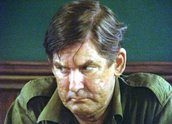

A Shifting Dreaming (1982)
Synopsis
A partly-dramatised documentary by Bob Plasto, which attempts to trace Indigenous and non-Indigenous relations through three significant events: the Coniston massacre in the Northern Territory in 1928 in which members of the Warlpiri tribe were killed, the resulting Federal Inquiry into the Killing of Natives in Central Australia, and the proceedings of the Kaytej (Kaytetye), Warlpiri and Warlmanpa Lands Rights hearing in 1982. The documentary’s shifts between past and present are facilitated by the narration of Jack Thompson and prompted by the memories of the descendants of the massacre and those of participants in the 1982 hearings. Courtroom transcripts from the 1928 inquiry into the massacre are brought to life by re-enactments based on the personal testimony of the officials involved in the massacre.
Curator’s notes
The 1928 Coniston massacre of the Warlpiri people and the Aboriginal Land Rights claim in the same area over 50 years later are presented as a continuing thread in the relationship between Indigenous and non-Indigenous Australia. For viewers unfamiliar with either event, it is sometimes difficult to sort out the facts as they stand from the interpretation of these facts as presented through both the narration by Jack Thompson and by the dramatisation of the events.
The film attempts to draw together many complex strands of Australia’s history and bring to life the 1928 Federal Inquiry into the Killing of Natives in Central Australia. The board of inquiry eventually found that William George Murray – then chief protector of Aborigines in the Territory – and his subordinates did not intentionally kill any of the Aborigines and no one was charged or convicted over their deaths. Bringing historical documents to life is a challenge for documentary makers and the choice to use dramatised recreation does allow the transcripts to come off the page, but it’s unclear at times whose version of events is being re-enacted and how much licence has been taken for dramatic effect. The narration, read and presented on-camera by Jack Thompson, presents a European perspective on the legal system and land ownership, providing limited insight into the cultural differences in attitude to laws, lores and land. Nevertheless, by highlighting that the impact of the Coniston massacre continues to resonate today amongst Aboriginal people, A Shifting Dreaming does attempt to understand the relationship between the past and the present. More recently the story of the Coniston massacre has been re-told from an Aboriginal perspective based on oral histories handed down from generation to generation in the documentaries My Mother’s Country Part 1 and My Mother’s Country Part 2. Another film, Whispering in Our Hearts, sensitively explores the conflict between Indigenous oral history and Western written history when recounting a massacre that took place in 1918.
Secondary curator’s notes
by Romaine MoretonIn December 1981 Bob Plasto obtained permission to film an Aboriginal land rights hearing to be held south of Alice Springs – proceedings conducted by the Central Land Council in accordance with the Aboriginal Land Rights (Northern Territory) Act 1976 (Cth) (ALRA). The meeting which Plasto filmed was the Kaytej (Kaytetye), Warlpiri and Warlmanpa land claim hearing before Justice Toohey, the first Land Rights Commissioner, appointed in 1977. During this hearing, memories of the 1928 Coniston massacre resurfaced, as the killings occurred in and around the land under claim. It is this convolution of facts that is the basis of A Shifting Dreaming.
A Shifting Dreaming is described as a dramatised documentary, and the constant movement between the re-enactment of the 1928 Federal Inquiry into the Killing of Natives in Central Australia held at the Alice Springs Telegraph and the ALRA meeting of 1981 is confusing for a number of reasons. The filmmaker’s attempt to explain Indigenous cosmology and rights to land was always going to be ambitious, as translation between western and Indigenous cultures is a complex process involving negotiation of language. Also, while the Coniston massacre is an event connected with the 1981 land claim, the documentary itself does not make this connection clear.
The narration by Jack Thompson as scripted by Rob Plasto and John Cribbin at first promises an engaging exposé on Indigenous cosmology but is instead loaded with overtones of conflict and warfare that positions white pastoralists as the victims of the ALRA. The narration is very problematic, with the narrator using terms that position Indigenous people as either aggressors or childlike. ‘The Aborigines’, according to the narration, are people who are now mastering the legal system to once again draw a distinct line between black and white. The narrative is dominated by the re-enactment of the inquiry into the Coniston massacre which describes the indiscriminate killing of Aboriginal people that took place over weeks, and was eventually found to be the fault of the Aborigines themselves. Nonetheless, the pastoralists, the narrator claims, have ‘honorably earned the right’ to the land.
- Overview
- Curator’s notes
- Video 2 clips
- Principal credits
- Find a copy
- Make a comment
- Add your review




